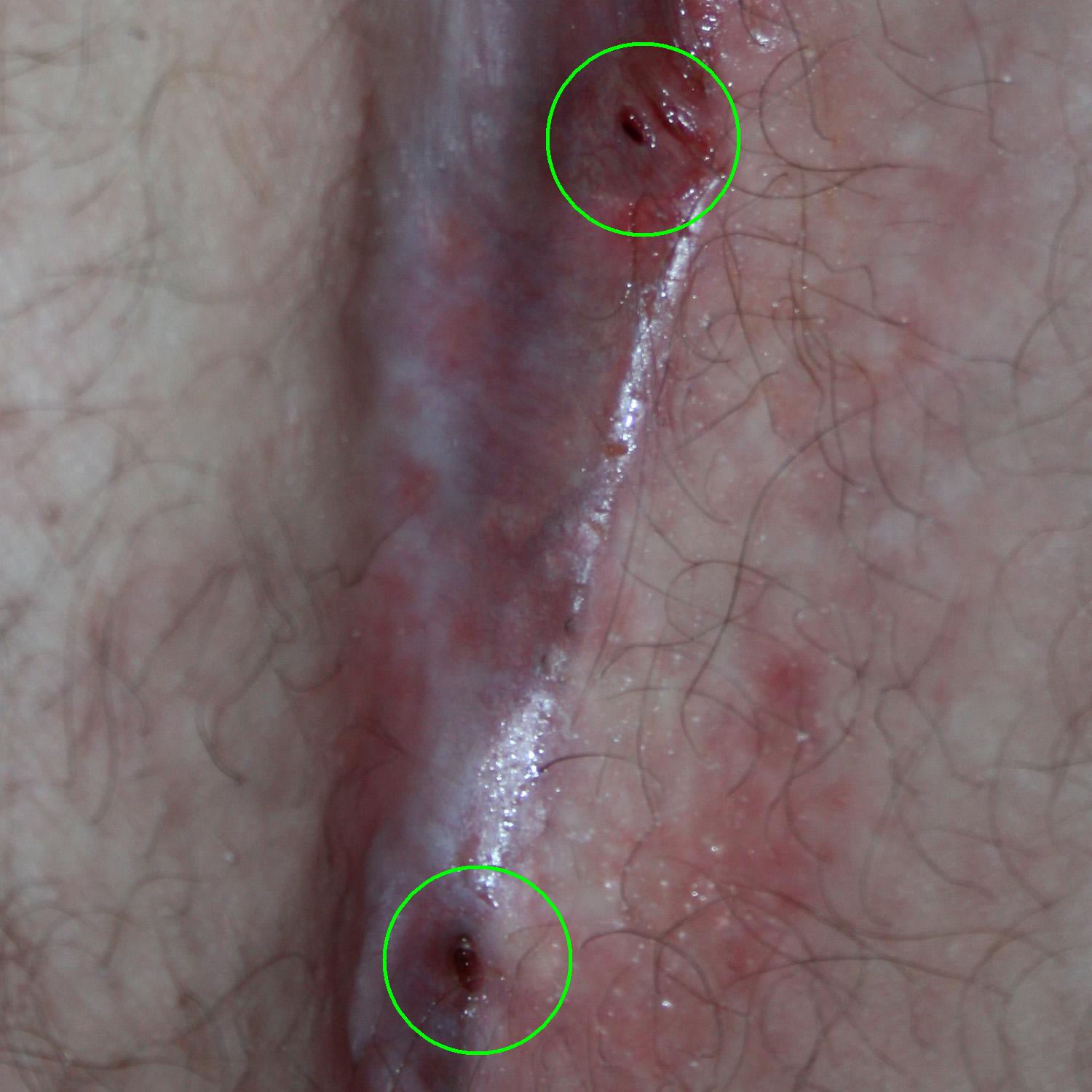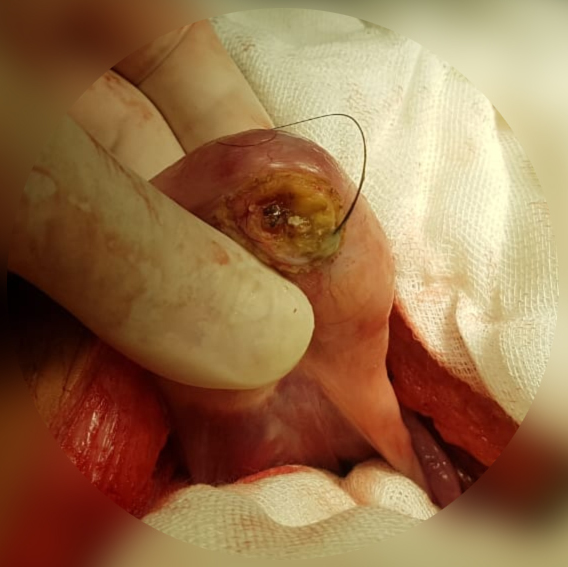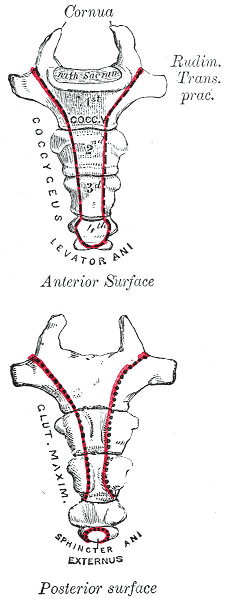|
Pilonidal Sinus
Pilonidal disease is a type of skin infection which typically occurs as a cyst between the cheeks of the buttocks and often at the upper end. Symptoms may include pain, swelling, and redness. There may also be drainage of fluid, but rarely a fever. Risk factors include obesity, family history, prolonged sitting, greater amounts of hair, and not enough exercise. The underlying mechanism is believed to involve a mechanical process. The lesions may contain hair and skin debris. Diagnosis is based on symptoms and examination. If there is infection, treatment is generally by incision and drainage just off the midline. Shaving the area and laser hair removal may prevent recurrence. More extensive surgery may be required if the disease recurs. Antibiotics are usually not needed. Without treatment the condition may remain long term. About 3 per 10,000 people per year are affected, and it occurs more often in males than females. Young adults are most commonly affected. The term "pil ... [...More Info...] [...Related Items...] OR: [Wikipedia] [Google] [Baidu] |
Gluteal Cleft
The intergluteal cleft or just gluteal cleft, also known by a number of synonyms, including natal cleft, butt crack, and cluneal cleft, is the groove between the buttocks that runs from just below the sacrum to the perineum, so named because it forms the visible border between the external rounded protrusions of the gluteus maximus muscles. Other names are the ''anal cleft'', ''crena analis'', ''crena interglutealis'', and ''rima ani''. Colloquially the intergluteal cleft is known as ''bum crack'' (UK) or ''butt crack'' (US). The intergluteal cleft is located superior to the anus. There are several disorders that can affect the intergluteal cleft including inverse psoriasis, caudal regression syndrome, and pilonidal disease. See also * Buttock cleavage * Rectum *Anal canal * * *Anatomical terms of location References External links Buttocks {{anatomy-stub ... [...More Info...] [...Related Items...] OR: [Wikipedia] [Google] [Baidu] |
Navel
The navel (clinically known as the umbilicus, commonly known as the belly button or tummy button) is a protruding, flat, or hollowed area on the abdomen at the attachment site of the umbilical cord. All placental mammals have a navel, although it is generally more conspicuous in humans. Structure The umbilicus is used to visually separate the abdomen into quadrants. The umbilicus is a prominent scar on the abdomen, with its position being relatively consistent among humans. The skin around the waist at the level of the umbilicus is supplied by the tenth thoracic spinal nerve (T10 dermatome). The umbilicus itself typically lies at a vertical level corresponding to the junction between the L3 and L4 vertebrae, with a normal variation among people between the L3 and L5 vertebrae. Parts of the adult navel include the "umbilical cord remnant" or "umbilical tip", which is the often protruding scar left by the detachment of the umbilical cord. This is located in the center of the ... [...More Info...] [...Related Items...] OR: [Wikipedia] [Google] [Baidu] |
Germ Cell Tumor
Germ cell tumor (GCT) is a neoplasm derived from germ cells. Germ-cell tumors can be cancerous or benign. Germ cells normally occur inside the gonads (ovary and testis). GCTs that originate outside the gonads may be birth defects resulting from errors during development of the embryo. Classification GCTs are classified by their histology, regardless of location in the body. However, as more information about the genetics of these tumors become available, they may be classified based on specific gene mutations that characterize specific tumors. They are broadly divided in two classes: * The germinomatous or seminomatous germ-cell tumors (GGCT, SGCT) include only germinoma and its synonyms dysgerminoma and seminoma. * The nongerminomatous or nonseminomatous germ-cell tumors (NGGCT, NSGCT) include all other germ-cell tumors, pure and mixed. The two classes reflect an important clinical difference. Compared with germinomatous tumors, nongerminomatous tumors tend to grow faster, have ... [...More Info...] [...Related Items...] OR: [Wikipedia] [Google] [Baidu] |
Teratoma
A teratoma is a tumor made up of several different types of tissue, such as hair, muscle, teeth, or bone. Teratomata typically form in the ovary, testicle, or coccyx. Symptoms Symptoms may be minimal if the tumor is small. A testicular teratoma may present as a painless lump. Complications may include ovarian torsion, testicular torsion, or hydrops fetalis. They are a type of germ cell tumor (a tumor that begins in the cells that give rise to sperm or eggs). They are divided into two types: mature and immature. Mature teratomas include dermoid cysts and are generally benign. Immature teratomas may be cancerous. Most ovarian teratomas are mature. In adults, testicular teratomas are generally cancerous. Definitive diagnosis is based on a tissue biopsy. Treatment of coccyx, testicular, and ovarian teratomas is generally by surgery. Testicular and immature ovarian teratomas are also frequently treated with chemotherapy. Teratomas occur in the coccyx in about one in 30,000 n ... [...More Info...] [...Related Items...] OR: [Wikipedia] [Google] [Baidu] |
Dermoid Cyst
A dermoid cyst is a teratoma of a cystic nature that contains an array of developmentally mature, solid tissues. It frequently consists of skin, hair follicles, and sweat glands, while other commonly found components include clumps of long hair, pockets of sebum, blood, fat, bone, nail, teeth, eyes, cartilage, and thyroid tissue. As dermoid cysts grow slowly and contain mature tissue, this type of cystic teratoma is nearly always benign. In those rare cases wherein the dermoid cyst is malignant, a squamous cell carcinoma usually develops in adults, while infants and children usually present with an endodermal sinus tumor.Freedberg, et al. (2003). ''Fitzpatrick's Dermatology in General Medicine''. (6th ed.). McGraw-Hill. . Location Due to its classification, a dermoid cyst can occur wherever a teratoma can occur. Vaginal and ovarian dermoid cysts Ovaries normally grow cyst-like structures called follicles each month. Once an egg is released from its follicle during ovulation, ... [...More Info...] [...Related Items...] OR: [Wikipedia] [Google] [Baidu] |
Relative Incidence Of Cutaneous Cysts
Relative may refer to: General use *Kinship and family, the principle binding the most basic social units society. If two people are connected by circumstances of birth, they are said to be ''relatives'' Philosophy *Relativism, the concept that points of view have no absolute truth or validity, having only relative, subjective value according to differences in perception and consideration, or relatively, as in the relative value of an object to a person *Relative value (philosophy) Economics *Relative value (economics) Popular culture Film and television * ''Relatively Speaking'' (1965 play), 1965 British play * ''Relatively Speaking'' (game show), late 1980s television game show * ''Everything's Relative'' (episode)#Yu-Gi-Oh! (Yu-Gi-Oh! Duel Monsters), 2000 Japanese anime ''Yu-Gi-Oh! Duel Monsters'' episode *'' Relative Values'', 2000 film based on the play of the same name. *''It's All Relative'', 2003-4 comedy television series *''Intelligence is Relative'', tag line for t ... [...More Info...] [...Related Items...] OR: [Wikipedia] [Google] [Baidu] |
Anaerobic Bacteria
An anaerobic organism or anaerobe is any organism that does not require molecular oxygen for growth. It may react negatively or even die if free oxygen is present. In contrast, an aerobic organism (aerobe) is an organism that requires an oxygenated environment. Anaerobes may be unicellular (e.g. protozoans, bacteria) or multicellular. Most fungi are obligate aerobes, requiring oxygen to survive. However, some species, such as the Chytridiomycota that reside in the rumen of cattle, are obligate anaerobes; for these species, anaerobic respiration is used because oxygen will disrupt their metabolism or kill them. Deep waters of the ocean are a common anoxic environment. First observation In his letter of 14 June 1680 to The Royal Society, Antonie van Leeuwenhoek described an experiment he carried out by filling two identical glass tubes about halfway with crushed pepper powder, to which some clean rain water was added. Van Leeuwenhoek sealed one of the glass tubes using a flame and ... [...More Info...] [...Related Items...] OR: [Wikipedia] [Google] [Baidu] |
Sacral Dimple
A sacral dimple (also termed pilonidal dimple or spinal dimple) is a small depression in the skin, located just above the buttocks. The name comes from the sacrum, the bone at the end of the spine, over which the dimples are found. A sacral dimple is defined as a midline dimple less than 5 mm in diameter and no further than 2.5 cm from the anus without associated visible drainage or hairy tuft. Sacral dimples are common benign congenital anomalies found in up to 4% of the population. Kucera, J. N., Coley, I., O’Hara, S., Kosnik, E. J., & Coley, B. D. (2015). The simple sacral dimple: diagnostic yield of ultrasound in neonates. Pediatric Radiology, 45(2), 211–216. https://doi.org/10.1007/s00247-014-3110-1 Other common benign congenital anomalies include supernumerary digits, third nipples and natal teeth. Wu, W., & Kamat, D. (2020). A Review of Benign Congenital Anomalies. Pediatric Annals, 49(2), e66–e70. https://doi.org/10.3928/19382359-20200121-03 Most sacaral dimple ... [...More Info...] [...Related Items...] OR: [Wikipedia] [Google] [Baidu] |
Coccygeal
The coccyx ( : coccyges or coccyxes), commonly referred to as the tailbone, is the final segment of the vertebral column in all apes, and analogous structures in certain other mammals such as horses. In tailless primates (e.g. humans and other great apes) since ''Nacholapithecus'' (a Miocene hominoid),Nakatsukasa 2004, ''Acquisition of bipedalism'' (SeFig. 5entitled ''First coccygeal/caudal vertebra in short-tailed or tailless primates.''.) the coccyx is the remnant of a vestigial tail. In animals with bony tails, it is known as ''tailhead'' or ''dock'', in bird anatomy as ''tailfan''. It comprises three to five separate or fused coccygeal vertebrae below the sacrum, attached to the sacrum by a fibrocartilaginous joint, the sacrococcygeal symphysis, which permits limited movement between the sacrum and the coccyx. Structure The coccyx is formed of three, four or five rudimentary vertebrae. It articulates superiorly with the sacrum. In each of the first three segments may be ... [...More Info...] [...Related Items...] OR: [Wikipedia] [Google] [Baidu] |
Mayo Clinic
The Mayo Clinic () is a nonprofit American academic medical center focused on integrated health care, education, and research. It employs over 4,500 physicians and scientists, along with another 58,400 administrative and allied health staff, across three major campuses: Rochester, Minnesota; Jacksonville, Florida; and Phoenix/Scottsdale, Arizona. The practice specializes in treating difficult cases through tertiary care and destination medicine. It is home to the top-15 ranked Mayo Clinic Alix School of Medicine in addition to many of the highest regarded residency education programs in the United States. It spends over $660 million a year on research and has more than 3,000 full-time research personnel. William Worrall Mayo settled his family in Rochester in 1864 and opened a sole proprietorship medical practice that evolved under his sons, Will and Charlie Mayo, along with practice partners Stinchfield, Graham, Plummer, Millet, Judd, and Balfour, into Mayo Clinic. Toda ... [...More Info...] [...Related Items...] OR: [Wikipedia] [Google] [Baidu] |
Ingrown Hair
Ingrown hair is a condition where a hair curls back or grows sideways into the skin. The condition is most prevalent among people who have coarse or curly hair. It may or may not be accompanied by an infection of the hair follicle (folliculitis) or "razor bumps" (pseudofolliculitis barbae), which vary in size. While ingrown hair most commonly appears in areas where the skin is shaved or waxed (beard, legs, pubic region), it can appear anywhere. Anything that causes the hair to be broken off unevenly with a sharp tip can cause ingrown hairs. Ingrown hairs are also caused because of lack of natural exfoliation in the skin. Signs and symptoms Symptoms include rash, itching skin, and hair that remains in spite of shaving. The site of the ingrown hair forms a reddish, raised bump, similar in appearance to a pimple. Prevention When shaving, a few precautions can be taken to avoid taking showers and preparation of the skin before shaving. When shaving, applying the proper amount of l ... [...More Info...] [...Related Items...] OR: [Wikipedia] [Google] [Baidu] |
Sinus (anatomy)
A sinus is a sac or cavity in any organ or tissue, or an abnormal cavity or passage caused by the destruction of tissue. In common usage, "sinus" usually refers to the paranasal sinuses, which are air cavities in the cranial bones, especially those near the nose and connecting to it. Most individuals have four paired cavities located in the cranial bone or skull. Etymology ''Sinus'' is Latin for "bay", "pocket", "curve", or "bosom". In anatomy, the term is used in various contexts. The word "sinusitis" is used to indicate that one or more of the membrane linings found in the sinus cavities has become inflamed or infected. It is however distinct from a fistula, which is a tract connecting two epithelial surfaces. If left untreated, infections occurring in the sinus cavities can affect the chest and lungs. Sinuses in the body * Paranasal sinuses ** Maxillary ** Ethmoid ** Sphenoid ** Frontal * Dural venous sinuses ** Anterior midline *** Cavernous *** Superior petrosal *** I ... [...More Info...] [...Related Items...] OR: [Wikipedia] [Google] [Baidu] |







